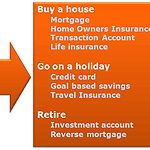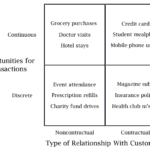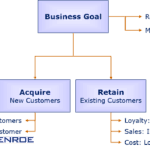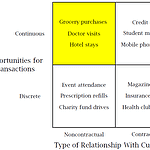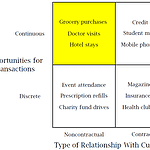Most of our clients see the ability to increase their cross sell rates as a good way to increase their overall share of the customer’s wallet and customer retention. One of the better cross selling techniques is the next logical product approach.
(Wondering “what is cross sell”?)
The next logical product approach to cross selling where you try to identify the product that the customer is most likely to buy next and then present them with a well timed offer to make the purchase.
It sounds very straight forward, and it is, but determining the next logical product (NLP) can take some time and effort. There are several ways to determine the next logical product for your customer:
Based on current holdings
If you have a relatively defined set of products or services then you can often determine the NLP based on what that customer has not already purchased. For instance consider an insurance company that sells building and car insurance. A simple NLP approach would be to look for all customers that have car insurance but do not have building insurance and create a building insurance offer for them.
As you can see this is a very simple approach to implement but doesn’t take into account a customer’s needs. You could very well be offering them a car policy when they have no car or a building policy when they are only renting.
Based on customer lifecycle
If you have a product set that lends itself, you can also generate your next logical product recommendations based on the stage of the customer lifecycle with your organisation. For instance if you are a business to business software supplier your customer probably goes through several stages of need.
Firstly they will buy the software and some training. After a few weeks or months they may need some implementation support to help them get the system in and operating correctly. After a year or two them may need help to take the implementation to the next level of complexity and so need some advanced systems consulting support. Lastly after 3 or 4 years you should be looking to have them upgrade to the next version of the software so that the process can start all over again.
At each of these stages you can clearly identify the customer’s next logical product and act accordingly.
Based on customer life stage
Another popular way to implement NLP is to try to guess where each person is in their overall lifestage (from birth to death) and select products that meet their needs. Typical life-stages you might consider include: single, newly married, married with young children, empty nesters, etc.
The simplest example of this is pension and superannuation companies who use the age of their customers as a cue to the products that they might need. For instance, the next logical product for a 30 year old customer is not an annuity based pension but it may be a college / university savings product for their current or future children.
On the other hand, a 63 year old customer may be thinking of retiring in the next few years, starting a conversation with them about an annuity pension product is probably just the right timing.
One of the major disadvantages of this approach is the increasingly complex nature of modern customer life stages. Increasing divorce rates, the availability of late in life fertility treatments, people working long after the official retirement age, etc, have made this approach very difficult to implement reliability.
Based on customer activity
Lastly, you can look at customer transactions or other activity and statistically determine the next logical product. Typically this requires advanced data analytics and a good volume of customer data and transactions. Often through the process of data mining you uncover unusual or unexpected linkages that you would not have uncovered using the above approaches.
For one client, where extensive work on product purchase propensity had been done, we simply used the product with the highest sales propensity as the next logical product. A very straight forward approach that worked very effectively for our client.
I've created an Excel Customer Lifetime Value Calculator: Download Here

